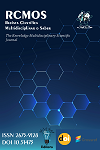O impacto da digitalização no marketing da empresa Linhas Aéreas de Moçambique (LAM) sede, na cidade de Maputo: Um estudo da relevância da marca
The impact of digitalization on the marketing of the company Linhas Aéreas de Moçambique (LAM) based in the city of Maputo: A study of brand relevance
DOI:
https://doi.org/10.51473/rcmos.v1i1.2025.900Palavras-chave:
digitalização, marketing, relevância da marca e aviaçãoResumo
Este estudo investiga o impacto da digitalização no marketing da Linhas Aéreas de Moçambique (LAM) e sua relevância no mercado, com foco na cidade de Maputo, no período de 2020 a 2023. A pesquisa analisa como a transformação digital influenciou o comportamento e as expectativas dos consumidores, as estratégias digitais adotadas pela LAM e a percepção da marca em um cenário cada vez mais competitivo e globalizado.
A digitalização, impulsionada pela pandemia de COVID-19, acelerou a adpoção de ferramentas digitais pela LAM, como reservas online, marketing em redes sociais e atendimento ao cliente via plataformas digitais. A pesquisa revelou que as redes sociais se tornaram a principal fonte de informação para os clientes, superando o site oficial em alguns aspectos. No entanto, o site ainda é considerado uma fonte confiável de informação, e as recomendações de amigos e familiares continuam a influenciar as decisões de compra.
A relevância da presença digital da LAM na escolha da companhia aérea para voos regionais e internacionais foi unânime entre os respondentes, demonstrando a importância de manter uma presença sólida e activa nas plataformas digitais. A pesquisa também identificou áreas de melhoria, como a necessidade de campanhas de marketing digital mais personalizadas e interativas, optimização do site e aplicativo da empresa e conteúdo mais relevante e engajador nas redes sociais.
Em suma, a digitalização transformou o cenário do marketing da LAM, exigindo que a empresa invista em estratégias digitais inovadoras e personalizadas para atender às expectativas dos clientes
e manter sua relevância no mercado. A LAM deve continuar a monitorar as tendências digitais e a adaptar suas estratégias para garantir que esteja sempre à frente da concorrência e oferecendo a melhor experiência possível aos seus clientes.
Downloads
Referências
Aaker, D. A. (1996). Building strong brands. (1ª. ed.). New York: Free Press. Aaker, D. A. (1991). Managing brand equity: Capitalizing on the value of a brand name. (1ª. ed.). New York: Free Press. B2B Marketing & Deloitte. (2022). Transformação digital no marketing B2B. Relatório de estudo, edição especial.
Brown, T. (2009). Change by Design: How Design Thinking Creates New Alternatives for Business and Society. HarperBusiness. Chaffey, D. (2015). Digital marketing: Strategy, implementation and practice. (6ª. ed.). London: Pearson Education Limited. Chaudhuri, A. & Holbrook, M. B. (2001). The chain of effects from brand trust and brand affect
to brand performance: The role of brand loyalty. Journal of marketing, 65(2), 81-93. Davenport, T. H. & Harris, J. G. (2010). Analytics at work: Smarter decisions, better results. (1ª. ed.). Cambridge, MA: Harvard usiness Review Press. Gensler, S., Völckner, F., Liu-Thompkins, Y. & Wiertz, C. (2013). Managing mrands in the social media environment. Journal of brand management, 21(7), 1-16. Harrigan, P., Ramsey, E. & Ibbotson, P. (2017). The role of digital and social media in customer engagement: A strategic framework. Journal of business research, 88, 398-406. Iansiti, M. & Lakhani, K. R. (2014). Digital Distruption: Unleashing the next wave of innovation. (1ª. ed.). Boston,MA: Harvard Business Review Press. Kaplan, A. M. & Haenlein, M. (2010). Users of the world, unite! The challenges and opportunities of social media. Business Horizons, 53(1), 59-68. Keller, K. L. (2001). Building Customer-Based Brand Equity. Marketing Management, 10(2), 14-19 Keller, K. L., & Lehmann, D. R. (2006). Brands and Branding: Research Findings and Future Priorities. Marketing Science, 25(6), 740–759. Keller, K. L. (2013). Strategic brand management. (4ª. ed.). Boston, MA: Pearson. Kotler, P. (2003). Marketing management. (11ª. ed.). Upper Saddle River: Prentice Hall. Kumar, V., Sharma, A. & P. S. (2020). The role of digital and social media marketing in consumer behavior. International Journal of Consumer Studies, 44(6), 759-770. Kaplan, A. M. & Haenlein, M. (2010). Users of the world, unite! The challenges and opportunities of social media. Business Horizons, 53(1), 59-68. Kotler, P. (2010). Marketing Management. (14ª. ed.). Pearson Kotler, P. & Keller, K. L. (2016). Marketing management. (15ª. ed.). Boston, MA: Pearson Education. Laroche, M., Habibi, M. R. & Richard, M. O. (2012). To be or not to be in social media: How
brand loyalty is affected by social media?. International Journal of Information
Management, 33(1), 76-82. Mangold, W. G. & Faulds, D. J. (2009). Social media: The new hybrid element of the promotion mix. Business Horizons, 52(4), 357-365. O’Reilly, T. (2018). WTF? What’s the Future and Why It’s Up to Us. Harper Business Peppers, D. & Rogers, M. (2016). Managing customer experience and relationships: A strategic framework. (3ª. ed.). Hoboken, NJ: Wiley. DOI: https://doi.org/10.1016/j.bushor.2009.03.002
Pine, J. B., & Gilmore, J. H. (1998). Welcome to the Experience Economy. Harvard Business
Review, 76(4), 97-105. Pulizzi, J. (2014). Content marketing strategy: The heart of content marketing. (1ª. ed.). Dublin, OH: Content Marketing Institute. Ramaswamy, V. & Ozcan, K. (2018). What is co-creation?*. In the new science of customer experience: Creating value through engagement and co-creation Solomon, M. R. (2018). Consumer behavior: Buying, having, and being. (12ª. ed.). Boston, MA: Pearson. Verhoef, P. C., Kannan, P. K. & Inman, J. J. (2015). From multi-channel retailing to omnichannel retailing: Introduction to the special issue on omnichannel retailing. Journal of Retailing, 91(2), 174-181. Verhoef, P. C., Kannan, P. K. & Inman, J. J. (2021). From multi-channel retailing to omni-channel retailing: Introduction to the special issue on omni-channel retailing. Journal of Retailing, 97(2), 204-211. Young & Rubicam. (2001). Brand Asset Valuator: The Brand Equity Model.
Downloads
Arquivos adicionais
Publicado
Edição
Seção
Categorias
Licença
Copyright (c) 2025 Dércio António Machava (Autor)

Este trabalho está licenciado sob uma licença Creative Commons Attribution 4.0 International License.
Este trabalho está licenciado sob a Licença Creative Commons Atribuição 4.0 Internacional (CC BY 4.0). Isso significa que você tem a liberdade de:
- Compartilhar — copiar e redistribuir o material em qualquer meio ou formato.
- Adaptar — remixar, transformar e construir sobre o material para qualquer propósito, inclusive comercial.
O uso deste material está condicionado à atribuição apropriada ao(s) autor(es) original(is), fornecendo um link para a licença, e indicando se foram feitas alterações. A licença não exige permissão do autor ou da editora, desde que seguidas estas condições.
A logomarca da licença Creative Commons é exibida de maneira permanente no rodapé da revista.
Os direitos autorais do manuscrito podem ser retidos pelos autores sem restrições e solicitados a qualquer momento, mesmo após a publicação na revista.













